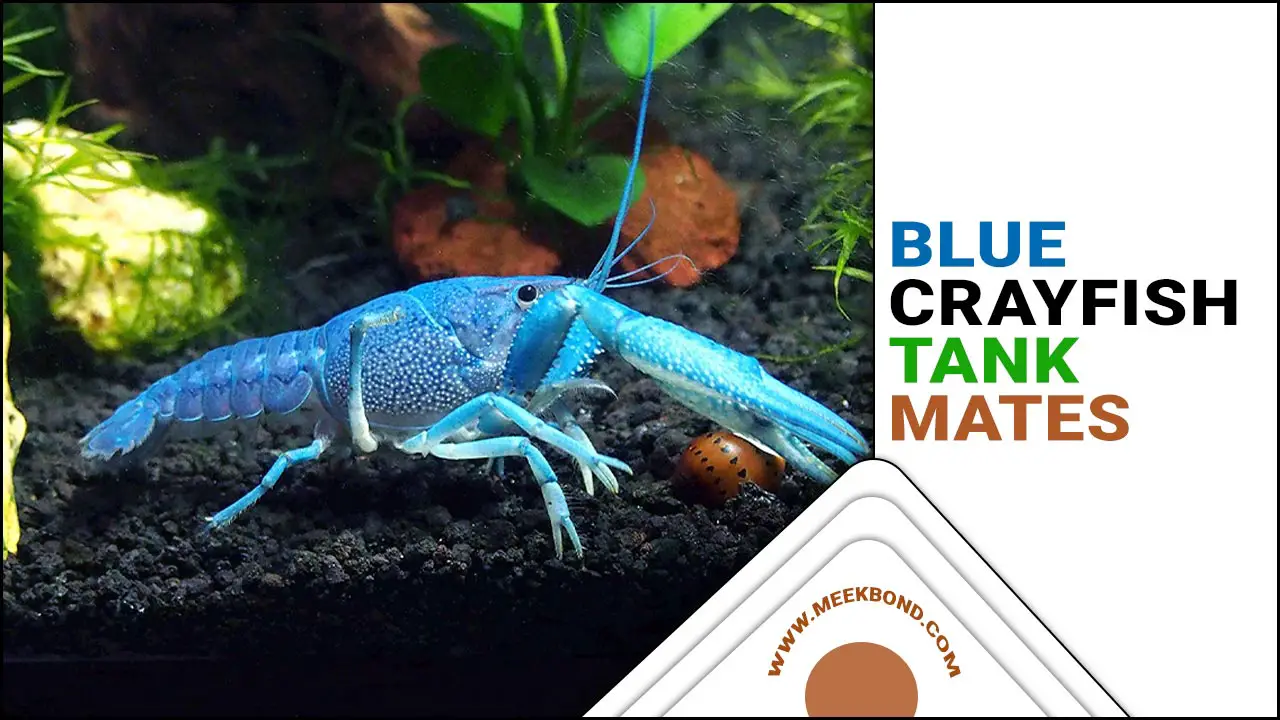Cleaning your fish tank is essential to maintaining a healthy and thriving aquatic ecosystem. Regular cleaning removes harmful toxins and debris from the water. But it also helps to maintain the overall aesthetic of your tank.
However, one common question many fish owners face is how long should i wait to put my fish back in the tank after cleaning? This is a crucial consideration, as improper timing could potentially harm your fish and disrupt the delicate balance of your tank.
We will explore the factors determining the appropriate wait time for putting your fish back in the tank after cleaning and provide some helpful tips to ensure a smooth and safe transition for your aquatic pets. With a proper understanding of this important aspect of fish tank maintenance. You can ensure the well-being of your fish and the longevity of your beautiful underwater world.
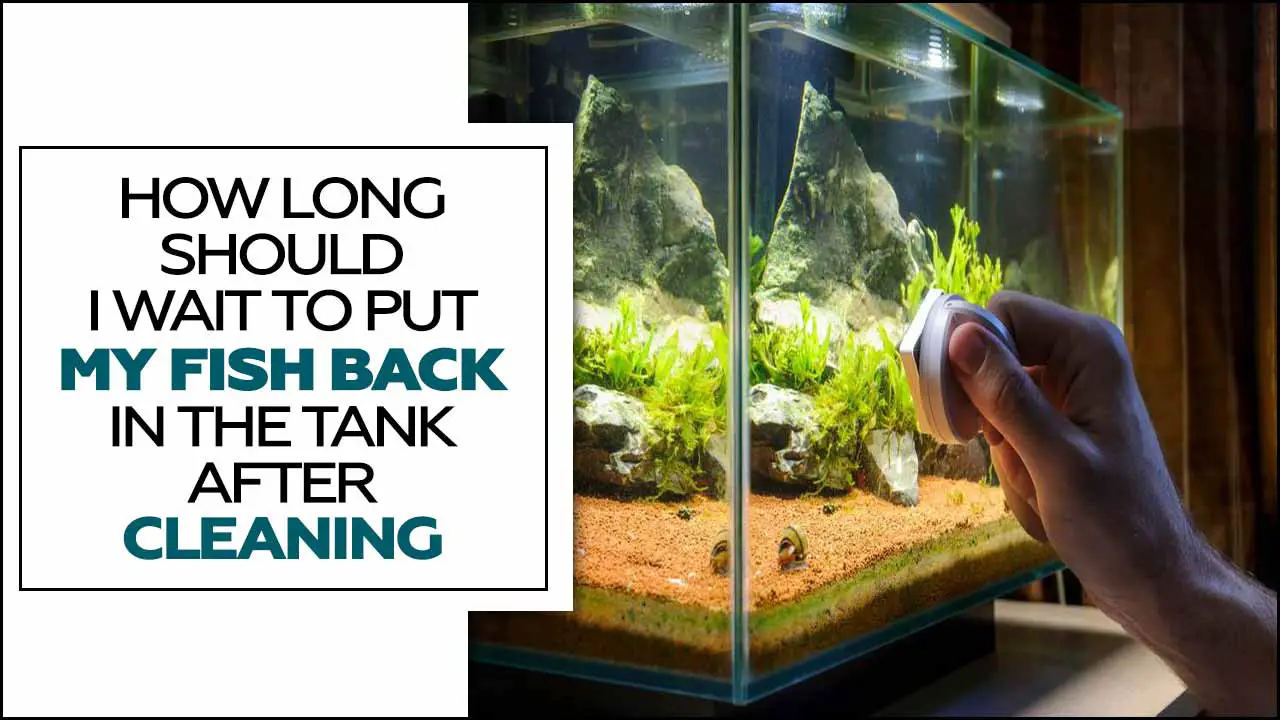
How Long Should I Wait To Put My Fish Back In The Tank After Cleaning? Answered

The amount of time it takes to put your fish back in the tank after cleaning depends on several factors. The size of the tank and the type of filter used are two important considerations. A larger tank will naturally require more time for the water quality to stabilize.
When cleaning your fish tank, waiting an appropriate amount before putting your fish back in is important. Harsh chemicals used during routine maintenance can harm the fish if reintroduced to the tank too soon. The length of time you should wait will depend on the specific chemicals used and the instructions provided by the manufacturer.
It is recommended to thoroughly rinse the tank and decorations with clean water after using any cleaning products. Additionally, testing the water parameters to ensure they are within a safe range for your fish is crucial before reintroducing them. A full tank cleaning requires more time for the water quality to return to its normal levels, so it is important to monitor the water parameters for at least 24 hours.
1.Prepare Your Tank For Proper Cleaning
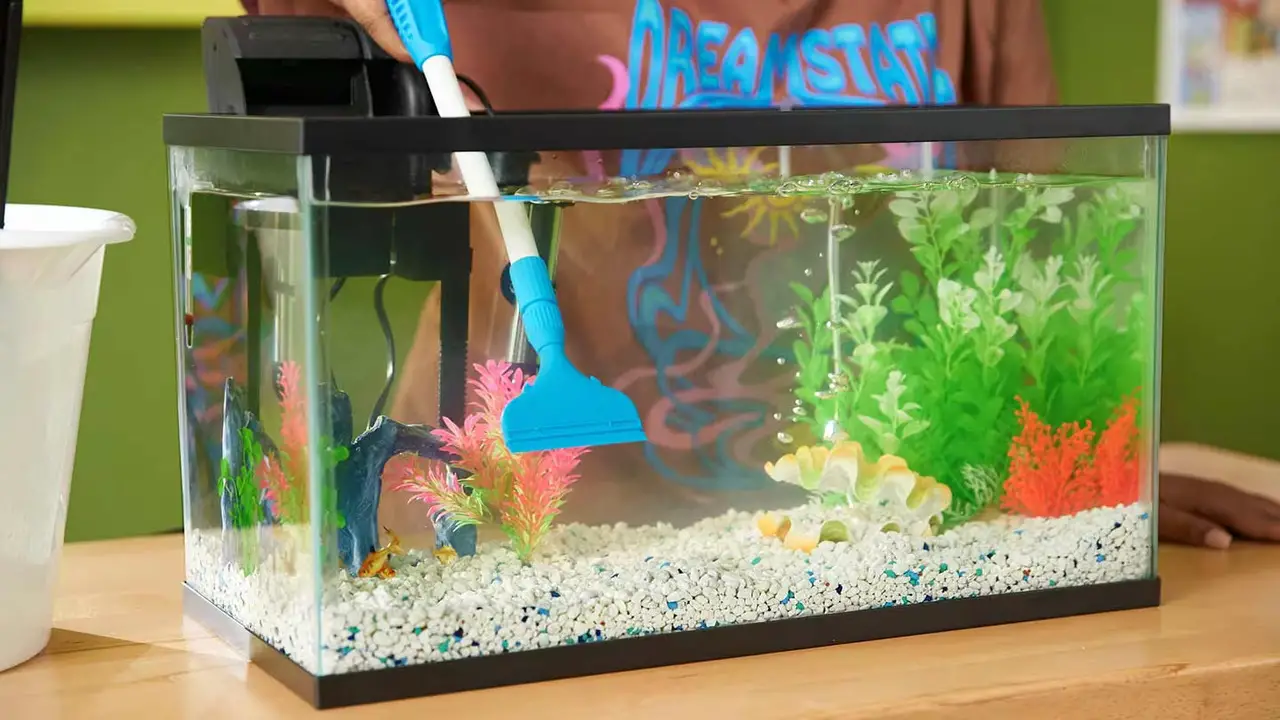
Preparing your tank for proper cleaning is essential in ensuring your fish can safely return to their habitat. Before removing your fish, turn off all electrical equipment, such as filters, heaters, and pumps.
Then, carefully remove your fish from the tank using a net and place them in a clean container filled with water. This will ensure they remain safe and healthy while you clean the tank. Cleaning your fish tank is essential to keep your fish healthy and prepare it for proper water cleaning.
2.Take The Fish Out In A Bowl
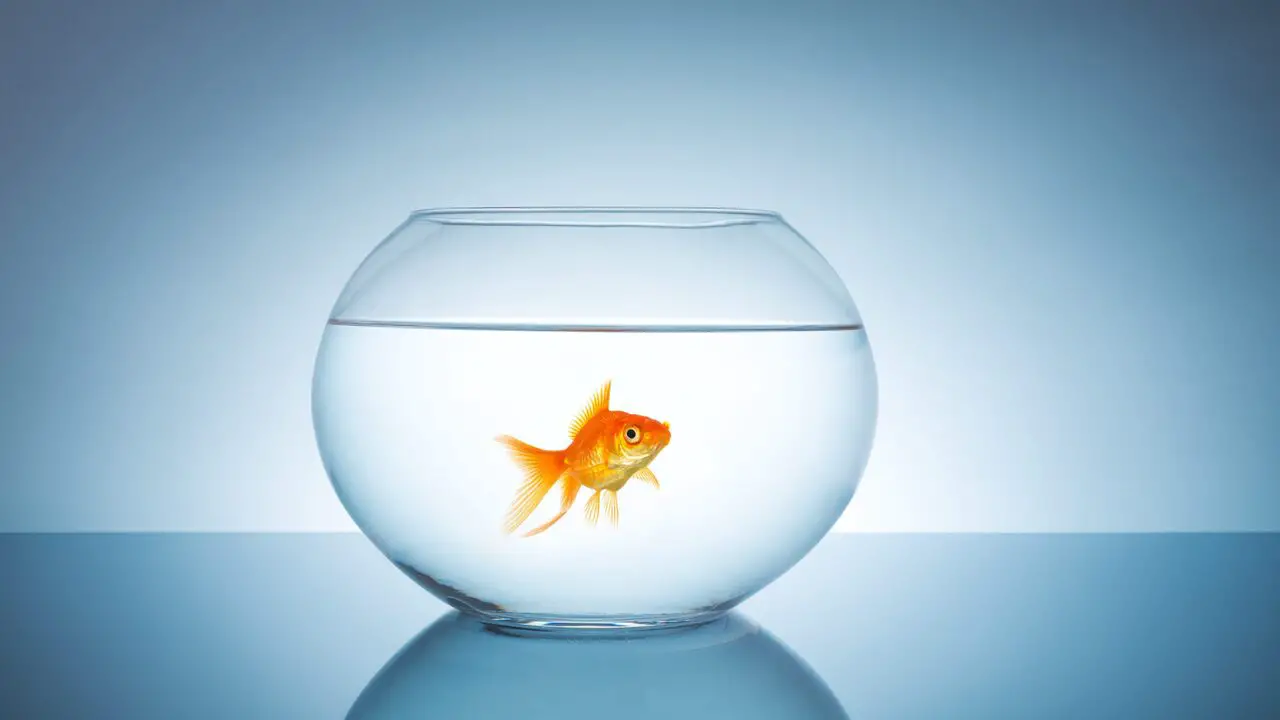
One of the best ways to keep fish healthy and happy is by cleaning them properly. If you’re unsure how to do this, use a bowl or siphon. To use a bowl. Put the fish in it and then pour water into the bowl until it covers the fish’s head and body.
The key is to ensure the water is deep enough so the fish can’t see the light from outside and suffocate. You can also do this using a siphon – place your hands over both ends of the tubing connected to an aquarium pump (or fountain).
And turn it on slowly while noting when water starts coming out at first speed. Then, gradually increase flow until the tank level matches what’s coming from a tube(s).
Once you have ensured that your fish are clean inside and out, be sure to store them correctly: In freshwater without chlorine; on gravel instead of sand; at least 18 inches away from other pets or people; temperatures around 78 degrees Fahrenheit during wintertime/lower 70 degrees Fahrenheit for summertime.
3.Clean The Tank
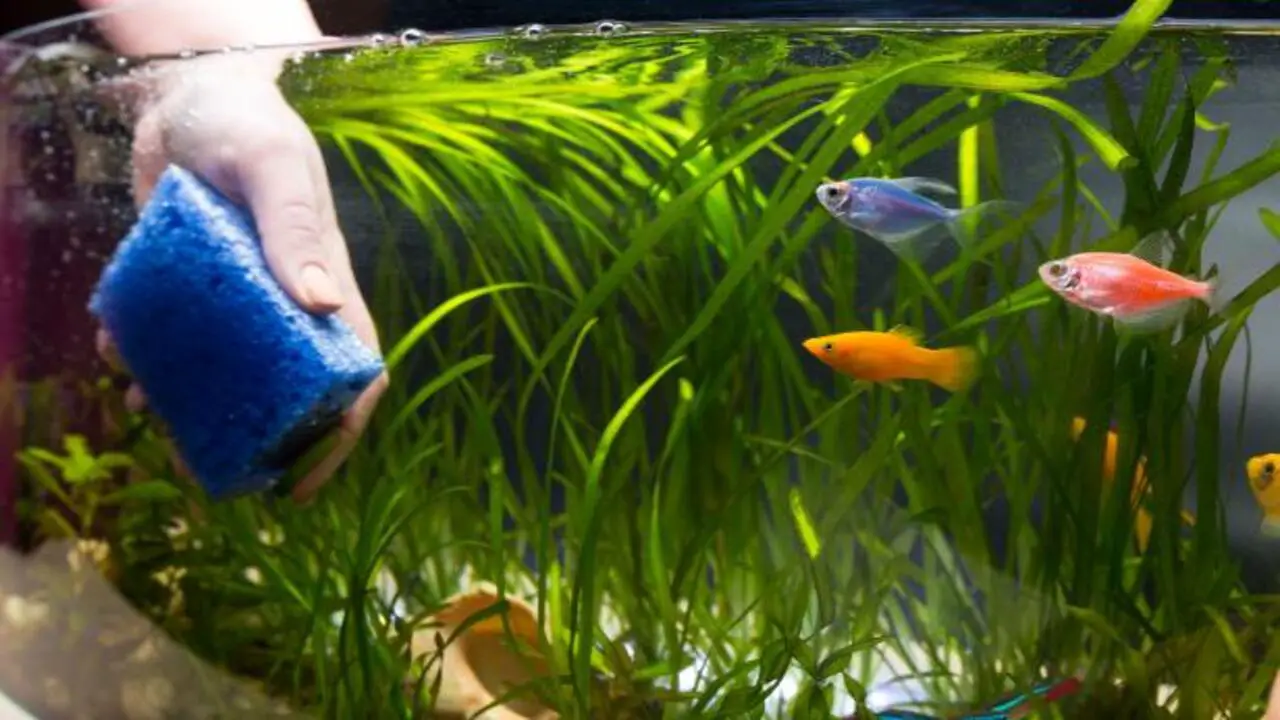
When cleaning your fish tank, giving your fish enough time to adjust before putting them back in is important. The length of time you should wait will depend on the specific cleaning methods you use and the size of your tank.
If you used an algae scraper to clean off algae growth, you may only need to wait a few minutes for the water to settle before reintroducing your fish. However, if you performed a deep cleaning or made significant changes to the tank, such as changing the water or rearranging decorations.
It is best to wait at least 24 hours before returning your fish. This will allow any chemicals or disturbances in the water to stabilize and ensure a safe and stress-free environment for your fish.
4.Change Tank Water
Changing tank water is an essential step in cleaning your fish tank. However, it can also be stressful for your fish when it’s time to put them back in the tank after changing the water. You can do a few things to make the process smoother and less stressful for your fish.
First, ensure that the water temperature in the tank matches the temperature of the water they were in before. This will help prevent shock and stress. Next, slowly acclimate your fish to the new water by adding a little water to their container for 10-15 minutes. Finally, gently release your fish into the tank and allow them time to adjust to their surroundings.
5.Put The Decorations Back
After cleaning your fish tank, giving the aquarium decorations time to settle before putting your fish back in is important. This will allow any residual cleaning chemicals or debris to dissipate and ensure a healthy environment for your fish. The exact amount of time you should wait can vary depending on the size of your tank and the type of tank decorations you have.
As a general rule, waiting at least 24 hours is recommended to allow the water quality to stabilize and any lingering chemicals to evaporate. However, it is always a good idea to test the water parameters before reintroducing your fish to ensure optimal conditions for their well-being. Here are four tips to help get the decorating process started:
- Ensure the water is at the correct temperature before putting your fish back in; they will not feel comfortable if it’s too cold or hot.
- Use a net to gently scoop them out of their tank and place them in a bowl; this will reduce stress and make for easier handling during aquarium adjustments later on.
- Replace any gravel, plant ornaments, etc., that your fish evacuation might have displaced – these items could cause injuries if ingested inadvertently by your new arrivals.
Lastly, ensure no dirt or leaves on the floor, as this could also lead to injury when stepped on accidentally by curious fish.
6.Add Conditioner To The Water
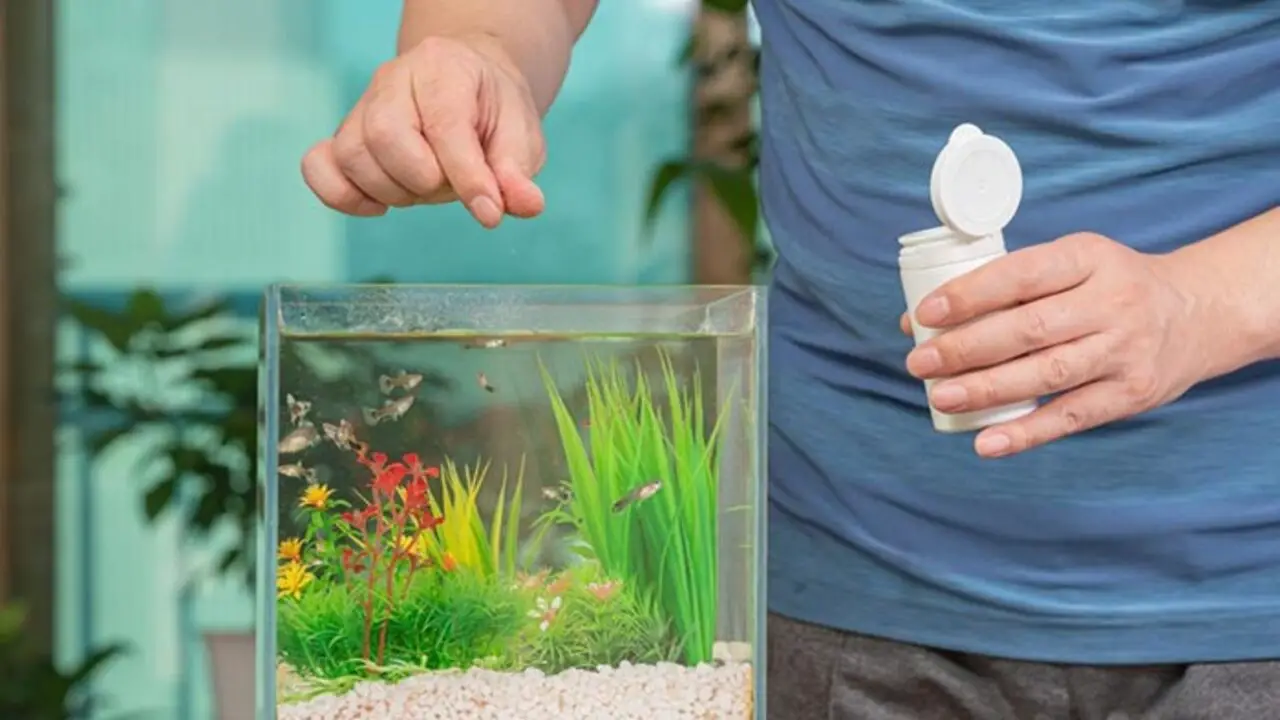
Adding water conditioner to aquarium water before introducing fish is essential to keeping them healthy. It helps to remove chlorine, chloramines, and other contaminants that can be harmful to your fish. If you use tap water in your tank, it is important to wait at least 30 minutes after adding the conditioner before putting your fish back in. This will allow the conditioner time to work and ensure your fish have safe and healthy water to swim in.
7.Put Your Fish Back In Tank Water
Ensuring their well-being by putting them back in tank water is important. This is because fish are highly sensitive to changes in temperature, pH levels, and water quality. You are returning them to their familiar tank water. You provide them with a stable, comfortable environment, supporting their health and reducing stress.
Additionally, abrupt changes in water conditions can lead to shock or even death for the fish. So, always handle your fish carefully and return them. To their tank water promptly after any necessary handling or maintenance tasks.
What Needs To Be Cleaned During Tank Cleaning?
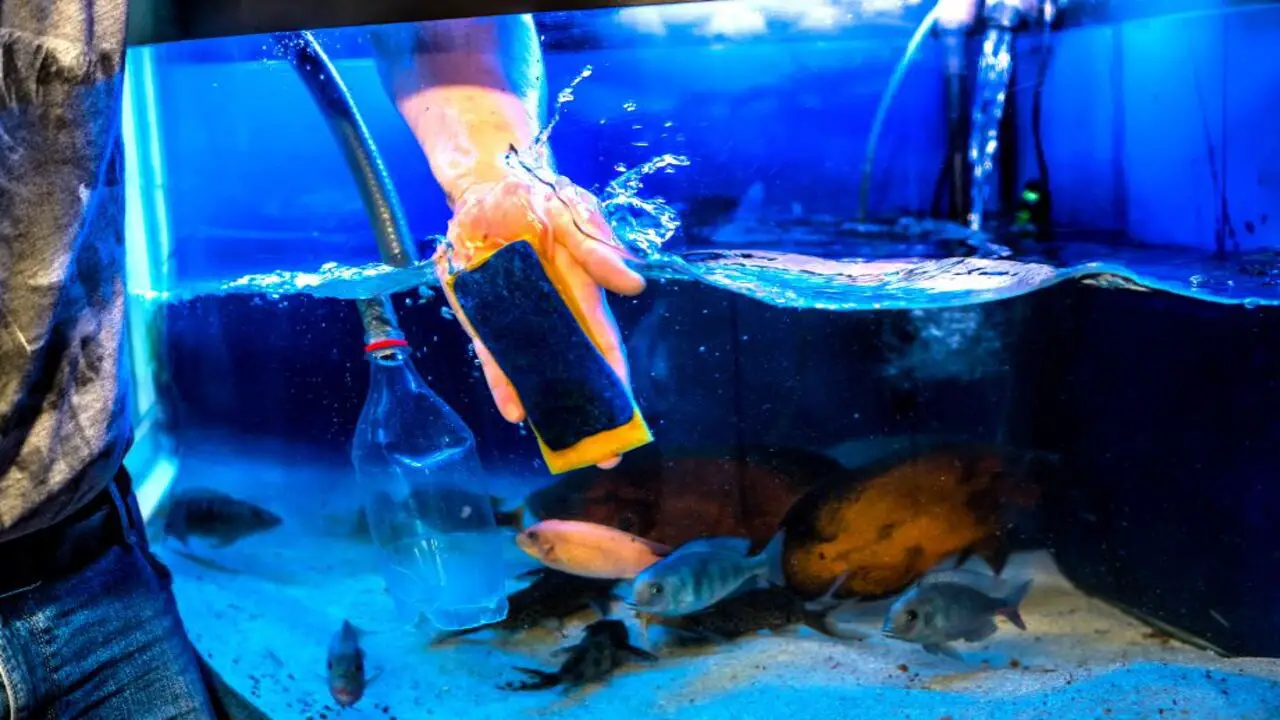
When cleaning your fish tank, it is important to clean several key components to ensure a healthy and thriving environment for your fish—regularly cleaning these key components. It can help ensure your aquatic pets’ clean and healthy living space.
Always use dechlorinated water and follow proper aquarium regular maintenance practices to keep your fish happy and thriving. Here are the main things that need to be cleaned during tank cleaning:
- Gravel Or Substrate: The gravel or substrate at the bottom of the tank should be vacuumed to remove any waste and debris that may have accumulated. This will help maintain water quality and prevent harmful toxins from building up.
- Decorations And Plants: Rocks, artificial plants, and ornaments should be rinsed off to remove algae or debris. They can also be scrubbed gently with a soft brush to remove stubborn stains or buildup.
- Filter Media: The filter media should be cleaned or replaced regularly depending on your filter type. This can include sponge filters, carbon filters, or biological media. Follow the manufacturer’s instructions for proper cleaning or replacement procedures.
- Glass Or Acrylic Walls: The tank’s walls should be wiped down with a clean cloth or sponge to remove any algae or residue that may have accumulated. Avoid using harmful chemicals, harsh chemicals or abrasive materials that could scratch the glass or acrylic.
- Water Change: As part of regular tank maintenance, it is important to perform partial water changes to remove excess nitrates and other pollutants from the water. This helps maintain water quality and provides a healthier environment for your fish.
The Importance Of Cleaning
Keeping your aquarium clean is vital to the health and happiness of your fish. Make sure to do a complete weekly water change to help keep the tank clean and bacteria-free. Additionally, use an aquarium cleaner regularly to remove all the dirt, dust, and debris.
If you’re unsure if your fish need cleaning, look at their colouration. Cleaning your fish in the tank is integral to maintaining a healthy and happy environment for your fish. First, ensure that you have added fresh water to the tank and that the temperature is appropriate for your fish species. Next, gently scoop up your fish with a net and release them slowly into the water.
Avoid pouring them in or dropping them from a height, as this can cause physical harm or shock. Remember to monitor your healthy fish closely after returning them to their tank and ensure they adjust well to their clean environment.
- Maintaining a clean and healthy environment for your fish is crucial to their well-being. When cleaning the tank, it is important to consider the appropriate amount of time to wait before putting your fish back in.
- This will allow any cleaning agents or chemicals to dissipate and ensure the water conditions are safe for your fish. The time you should wait can vary depending on your cleaning and the specific products used.
- It is recommended to follow the instructions provided with your cleaning products or consult with a professional for guidance.
- Ultimately, the goal is to prioritize the health and safety of your fish. So, taking the necessary precautions and allowing sufficient time for the tank to stabilize after cleaning is essential.
How Often Should I Feed Fish?
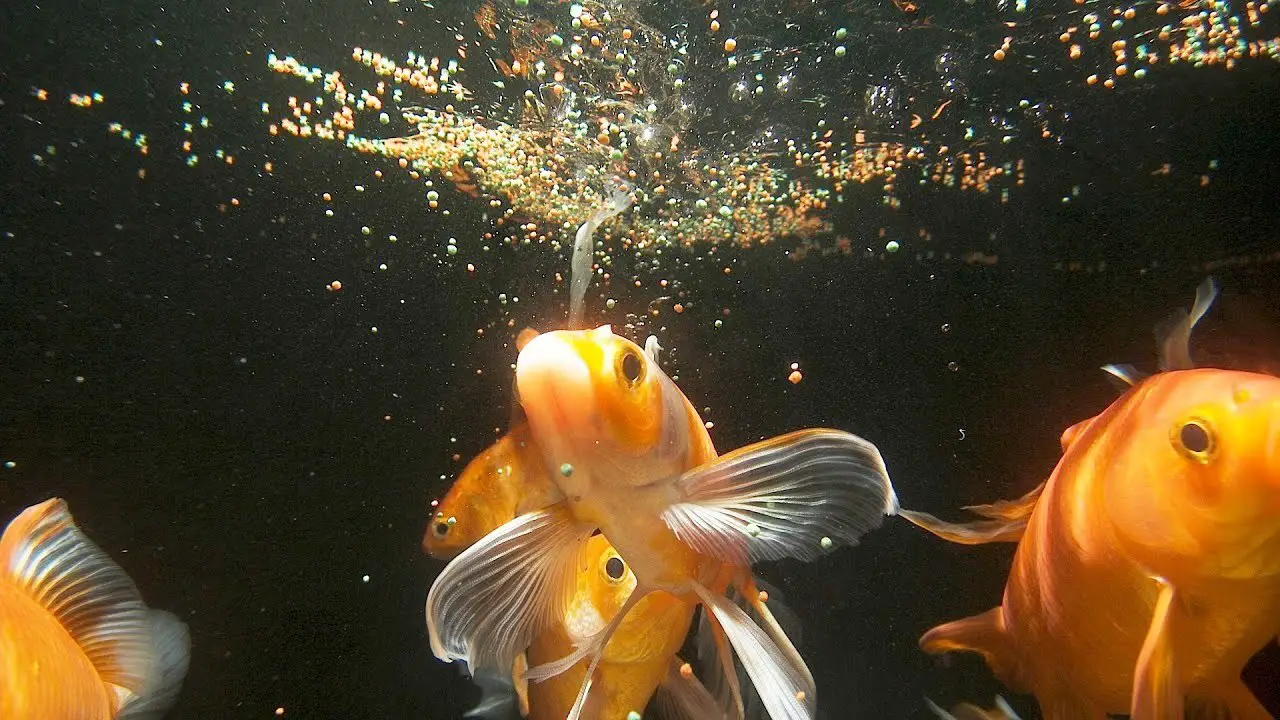
Feeding fish is an important aspect of maintaining a healthy freshwater aquarium. The frequency at which you should feed your aquarium fish will depend on several factors, including the type of fish you have and their specific dietary needs.
Generally, feeding your fish small amounts of food two to three times daily is recommended. This ensures that they get the nutrients they need without overfeeding them, which can lead to water quality issues and health issues for the dirty tank.
It is also important to consider the tank size and the number of fish you have, as overcrowding can impact feeding habits and water quality. You are observing your fish’s behaviour and monitoring water parameters. It can help you determine if you are feeding them enough or if adjustments must be made.
Conclusion
Cleaning your fish tank water is an important and necessary task for maintaining a healthy aquatic environment for your fish. However, allowing the necessary time for your tank to cycle before reintroducing your fish is crucial.
This will ensure their safety and prevent any potential harm from the changes in water parameters. It is recommended to wait at least 24 hours, but it is always best to consult with a professional or thoroughly research your specific fish species before changing their habitat.
It is always best to consult with a professional or do thorough research on the specific needs of your fish before making any changes to their environment. You can ensure the well-being of your fish and enjoy a clean and balanced tank. We hope that how long should i wait to put my fish back in the tank after cleaning?
Frequently Asked Questions
Can I Put The Fish Back In The Tank After Cleaning?
You can put the fish back in the tank after cleaning it, as long as you have properly prepared the tank and the water parameters suit the fish.
How Long Should You Wait To Put Fish In A Clean Tank?
It is generally recommended to wait at least 24-48 hours after cleaning a fish tank before introducing fish. This waiting period stabilises the water chemistry and ensures that any chemicals or treatments used during cleaning have dissipated.
Can Fish Survive In Clean Water?
Yes, fish can survive in clean water. Clean water provides the necessary oxygen and nutrients for fish to thrive. It is essential for their respiratory system and overall health. Fish can freely swim, breed, and maintain natural behaviours without pollutants or toxins.
How Long Can Fish Stay Out Of The Tank While Cleaning?
Fish should not be left out of the tank for more than 10-15 minutes while cleaning. This is to ensure their safety and reduce any stress they may experience when exposed to open air.
What Do I Do With My Fish While I Clean The Tank?
You can transfer your fish to a separate temporary container with some of the tank water while you clean the tank. Make sure the container is clean and free of any harmful substances.

Aquarium passion is all about connecting with the aquatic life and providing education to the public on the importance of these creatures. We showcase a wide variety of marine life through our exhibits as well as working with schools to provide unique learning opportunities for students of all ages.

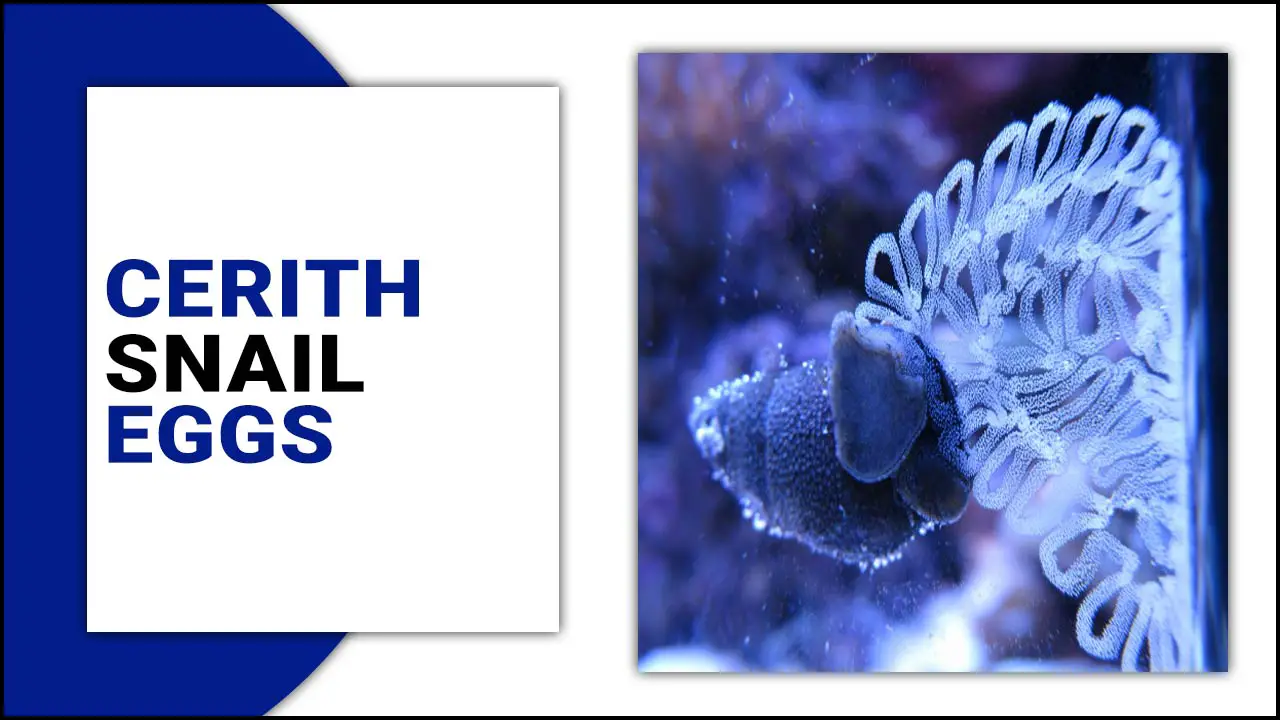
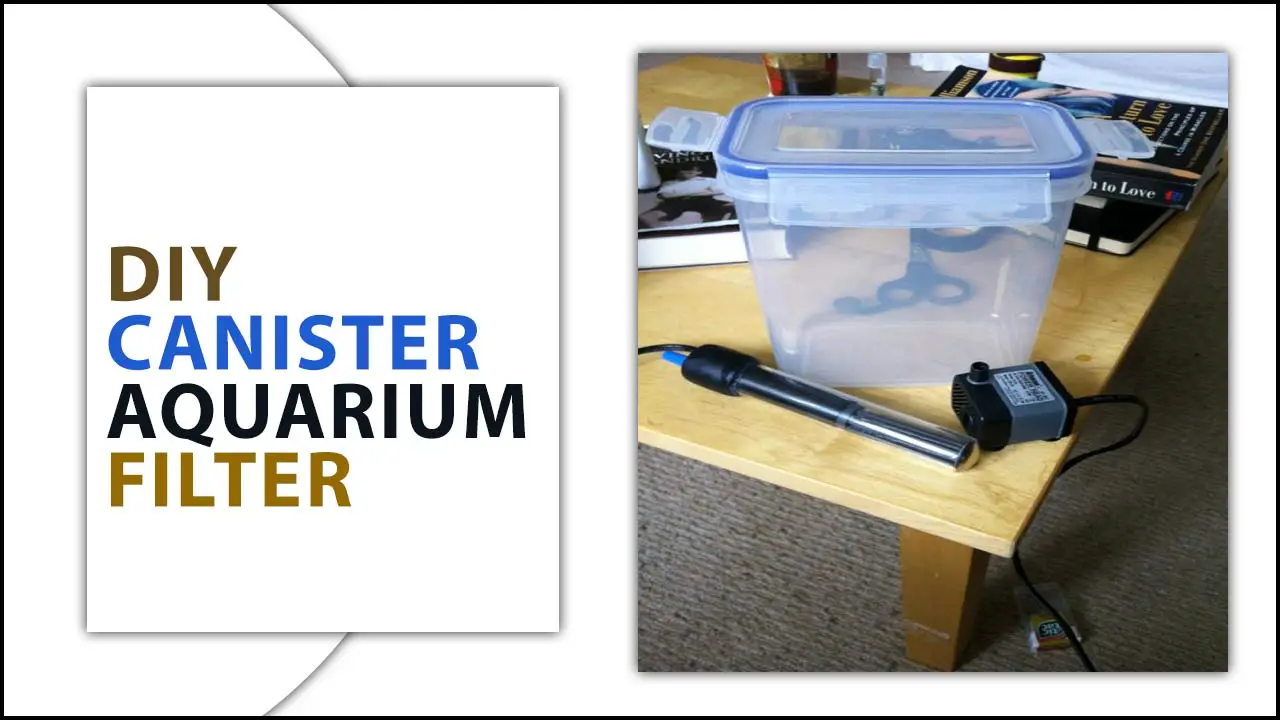
![How To Lower Ammonia In A Fish Tank [Sign With Solved]](https://meekbond.com/wp-content/uploads/2023/07/How-To-Lower-Ammonia-In-A-Fish-Tank.jpg)
